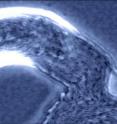Potential new strategy to reduce catheter blockage
Bacterial genes that make urine less acidic could be good targets to prevent catheter blockage, according to research presented at the Society for General Microbiology's Spring Conference in Harrogate. The findings could lead to new strategies to prevent serious infections, particularly in long-term catheterization patients. Urinary catheters are devices used in hospitals and community care homes to manage a range of bladder conditions, and are commonly used to manage incontinence in elderly individuals for long periods of time. Scientists from the University of Brighton, led by Dr Brian Jones, are looking at the bacterium Proteus mirabilis - a common cause of urinary tract infections in patients undergoing long-term catheterization, which often leads to serious complications.
P. mirabilis cells can stick together on catheter surfaces where they form highly organized communities called biofilms. As the bacterium breaks down urea (using the enzyme urease) it causes the pH of urine to rise, leading to the formation of insoluble crystals which become trapped in the growing biofilm. The crystalline deposits can form a crust on the catheter and may eventually block urine flow from the bladder. If unnoticed, catheter blockage can lead to kidney and bloodstream infections, which ultimately may result in potentially fatal septic shock.
The team is identifying genes involved in P. mirabilis biofilm formation, and assessing their contribution to catheter blockage. The results show that biofilm-forming ability may be less important to catheter blockage than previously thought, and suggest that inhibiting the rise in urinary pH is a primary target for preventing catheter blockage. Nina Holling who is carrying out the research said, "In our experiments we have found biofilm-forming ability not to be the most important factor in catheter blockage. Although biofilm formation does play a role, the ability of P. mirabilis to increase urinary pH and form crystals seems to compensate for deficiencies in biofilm formation. However, much more work is required to fully understand the progression of these infections and biofilm formation may be more important in the early stages of infection."
Ms Holling explained the significance of the team's work. "Long-term catheterization is linked with an increased mortality rate among nursing home patients, and effective strategies to control these infections are urgently required," she said. "A greater understanding of how P. mirabilis forms biofilms and behaves within them will be important in developing such strategies. In the longer term, this would greatly benefit patients undergoing long-term catheterization by eliminating painful recurrent infections, which greatly reduce quality of life. In addition, the financial savings to the NHS would be significant."
Source: Society for General Microbiology
Other sources
- Potential new strategy to reduce catheter blockagefrom PhysorgWed, 13 Apr 2011, 8:00:26 UTC
- Potential new strategy to reduce catheter blockagefrom Science DailyWed, 13 Apr 2011, 1:30:24 UTC
